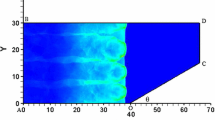Abstract
In accident scenarios where detonations can occur a concentration gradient constitutes a more realistic initial condition than a perfectly homogeneous mixture. In this paper, the influence of a concentration gradient on detonation front shape, detonation instabilities and pressure distribution is studied. First, a simple method to determine the front shape from a given fuel distribution is presented. It is based on Huygens’ principle and includes a correction to satisfy the boundary conditions on the enclosing walls. Next, the presented highly resolved Euler computations demonstrate the influence of a concentration gradient on detonation instabilities. In configurations with a strong concentration gradient, Mach reflection occurs and leads to an asymmetric pressure load on the enclosing geometry. In this case, the impulse on the wall is higher than in configurations with homogeneous fuel distribution, although the fuel content is much lower.
Similar content being viewed by others
References
Auban O., Zboray R., Paladino D.: Investigation of large-scale gas mixing and stratification phenomena related to LWR containment studies in the PANDA facility. Nuclear Eng. Des. 237, 409–419 (2007)
Breitung, W., Chan, C.K., Dorofeev, S., Eder, A., Gerland, B., Heitsch, M., Klein, R., Malliakos, A., Shepherd, J.E., Studer, E., Thibault, P.: Flame acceleration and deflagration-to-detonation transition in nuclear safety. OECD State-of-the-Art Report NEA/CSNI/R(2000)7 (2000)
Thomas G.O., Sutton P., Edwards D.H.: The behavior of detonation waves at concentration gradients. Combust. Flame 84, 312–322 (1991)
Vidal P.: Critical slow dynamics of detonation in a gas with non-uniform initial temperature and composition: a large-activation-energy analysis. Int. J. Spray Combust. Dyn. 1, 435–471 (2009)
Ettner, F., Vollmer, K.G., Sattelmayer, T.: Numerical investigation of DDT in inhomogeneous hydrogen–air mixtures. In: Eighth International Symposium on Hazards, Prevention and Mitigation of Industrial Explosions, Yokohama, Japan (2010)
Vollmer K.G., Ettner F., Sattelmayer T.: Influence of concentration gradients on flame acceleration in tubes. Sci. Technol. Energ. Mater. 72, 74–77 (2011)
Vollmer, K.G., Ettner, F., Sattelmayer, T.: Deflagration-to-detonation transition in hydrogen–air mixtures with concentration gradients. In: 23rd International Colloquium on the Dynamics of Explosions and Reactive Systems, Irvine, CA, USA (2011)
Kessler, D.A., Gamezo, V.N., Oran, E.S.: Detonation propagation through a gradient in fuel composition. In: 23rd International Colloquium on the Dynamics of Explosions and Reactive Systems, Irvine, CA, USA (2011)
Kessler D.A., Gamezo V.N., Oran E.S.: Gas-phase detonation propagation in mixture composition gradients. Phil. Trans. Roy. Soc. A 370, 567–596 (2012)
Ishii K., Kojima M.: Behavior of detonation propagation in mixtures with concentration gradients. Shock Waves 17, 95–102 (2007)
Osher S., Sethian J.A.: Fronts propagating with curvature-dependent speed: algorithms based on Hamilton–Jacobi formulations. J. Comput. Phys. 79, 12–49 (1988)
Bdzil, J.B., Stewart, D.S.: Modeling two-dimensional detonations with detonation shock dynamics. In: Sixth Army Conference on Applied Mathematics and Computing, Boulder, CO, USA (1988)
Aslam T.D., Stewart D.S.: Detonation shock dynamics and comparisons with direct numerical simulations. Combust. Theor. Model. 3, 77–101 (1999)
Denisov Yu.N., Troshin Ya.K.: On the mechanism of detonative combustion. Symp. (Int.) Combust. 8, 600–610 (1961)
Guo C., Wang C., Xu S., Zhang H.: Cellular pattern evolution in gaseous detonation diffraction in a 90°-branched channel. Combust. Flame 148, 89–99 (2007)
Anderson J.D.: Modern compressible flow with historical perspective, pp. 133–138. McGraw-Hill, New York (2004)
Kurganov A., Noelle S., Petrova G.: Semi discrete central-upwind schemes for hyperbolic conservation laws and Hamilton-Jacobi equations. SIAM J. Sci. Comput. 23, 707–740 (2001)
Lee J.H.S.: The detonation phenomenon, pp. 44. Cambridge University Press, Cambridge (2008)
Kee, R.J., Rupley, F.M., Miller, J.A.: The Chemkin thermodynamic data base. Sandia Report SAND87-8215B (1991)
O’Conaire M., Curran H.J., Simmie J.M., Pitz W.J., Westbrook C.K.: A comprehensive modeling study of hydrogen oxidation. Int. J. Chem. Kinet. 36, 603–622 (2004)
Author information
Authors and Affiliations
Corresponding author
Additional information
Communicated by L. Bauwens.
This paper is based on work that was presented at the 23rd International Colloquium on the Dynamics of Explosions and Reactive Systems, Irvine, California, USA, 24–29 July 2011.
Rights and permissions
About this article
Cite this article
Ettner, F., Vollmer, K.G. & Sattelmayer, T. Mach reflection in detonations propagating through a gas with a concentration gradient. Shock Waves 23, 201–206 (2013). https://doi.org/10.1007/s00193-012-0385-8
Received:
Revised:
Accepted:
Published:
Issue Date:
DOI: https://doi.org/10.1007/s00193-012-0385-8



